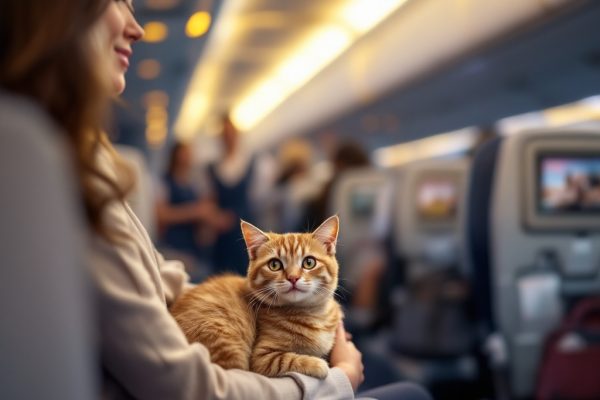Traveling with a Toddler: How to Avoid Common Issues
Traveling with a toddler? Get ready for an adventure! From disrupted sleep to tantrums, this article addresses the unique challenges of traveling with little ones. Discover expert tips, backed by the *Journal of Family Psychology*, on managing expectations, maintaining routines, and packing essential gear. Learn how to navigate air travel, long car rides, and handle difficult situations with ease. Transform potential travel stress into a smoother, more enjoyable experience for the whole family. Read on to unlock the secrets to a successful toddler travel adventure.
Important information

- Traveling with toddlers requires patience and flexibility due to potential sleep disruptions, tantrums, and difficulty with regular mealtimes.
- Prioritize your child’s comfort by packing familiar items, maintaining routines as much as possible, and planning for downtime and breaks.
- Manage your own stress levels, as parental well-being directly impacts a child’s travel experience.
- Pack smart: Include essentials like diapers, wipes, snacks, drinks, a change of clothes, and comfort items.
- Plan for age-appropriate entertainment and activities to keep your toddler engaged during travel time.
Understanding the Challenges of Traveling with a Toddler
Traveling with a toddler presents unique challenges. Their delicate sleep routines are easily disrupted, often leading to crankiness and boredom. Therefore, patience and flexibility are essential. Expect the unexpected, like tantrums and difficulty maintaining regular mealtimes. Prioritizing your child’s comfort in unfamiliar surroundings is crucial. Over-scheduling and unrealistic expectations can add unnecessary stress. As the *Journal of Family Psychology* points out, parental well-being directly impacts a child’s experience, so managing your own stress is key. By anticipating potential challenges and preparing accordingly, you can create a smoother, more enjoyable trip for the whole family.
Challenges
- Disrupted sleep routines, leading to crankiness and boredom.
- Tantrums and difficulty maintaining regular mealtimes.
- Child’s discomfort in unfamiliar surroundings.
Solutions
- Practice patience and flexibility.
- Prioritize your child’s comfort.
- Manage your own stress levels.
- Avoid over-scheduling and unrealistic expectations.
Why Traveling with a Toddler is Different from Traveling Alone
Traveling with a toddler transforms the travel experience. It requires meticulous planning centered around your child’s needs, not your own. Packing essentials like diapers, snacks, and familiar comfort items is crucial. Flexibility becomes paramount, as toddlers are known for their unpredictable routines and quickly changing moods. Forget relaxing; this trip is about navigating the challenges of parenthood in unfamiliar surroundings. Be ready to adapt your plans and handle tantrums. However, remember that despite the challenges, traveling with your toddler can be a rewarding adventure. Here’s what you need to keep in mind:
Planning
Focus on your child’s needs, not your own. Pack essentials like diapers, snacks, and familiar comfort items. Flexibility is paramount, as toddlers have unpredictable routines and moods.
Challenges
Forget relaxation; this trip is about navigating parenthood in unfamiliar surroundings. Be ready to adapt your plans and handle tantrums.
Pack Smart
Bring essential supplies such as diapers, wipes, snacks, and your child’s favorite comfort items. This will make your trip much smoother.
Embrace Flexibility
Toddlers are unpredictable. Be prepared to adjust your plans and go with the flow.
Manage Expectations
This trip won’t be a relaxing getaway. It’s about navigating parenthood in a new environment. Be prepared for challenges.
Common Issues Faced by Parents
Keeping toddlers happy and safe involves addressing several key factors. Cranky spells can often be attributed to disrupted sleep, overstimulation, and unfamiliar surroundings. Constant supervision is crucial, especially near water, to ensure their safety. Adequate hydration is essential, so make sure they drink enough fluids. Regular meals and snacks also contribute to their overall well-being.
The Importance of Realistic Expectations
Traveling with toddlers presents unique challenges, so adjust your expectations accordingly. Be ready for disruptions to routines and potential delays. However, careful planning can ease the journey. Padding your schedule with extra time, even for simple outings like a park visit, significantly reduces stress and disappointment if plans shift. Accepting the inevitable hiccups will make your trip far more enjoyable. Here’s how to make your trip smoother:
Pack Smart. Bring essential supplies like snacks, drinks, diapers, wipes, and a change of clothes. A favorite toy or blanket can provide comfort.
Plan for Breaks. Regular stops for stretching, diaper changes, or snacks can prevent meltdowns and keep toddlers happy.
Entertainment is Key. Books, downloaded videos, or small toys can keep toddlers occupied during travel time.
Prioritize Comfort. A comfortable toddler is a happy toddler. Consider a travel stroller or carrier for easier mobility.
Embrace Flexibility. Be prepared to adjust your plans as needed. Toddlers are unpredictable, and flexibility is essential for a smooth trip.
Planning a Toddler-Friendly Trip
Traveling with a toddler can be a rewarding experience with careful planning. Choosing the right destination is key. Look for locations offering a variety of kid-friendly activities, such as zoos, aquariums, interactive museums, beaches, or parks with playgrounds. When selecting accommodations, prioritize hotels with amenities like cribs, high chairs, and play areas. Ensure family-friendly restaurants are nearby. Safety and stroller accessibility are also essential factors to consider.Smart timing can significantly impact your trip’s success. Traveling during the off-season often means fewer crowds and better deals on flights and accommodations. Consider your toddler’s nap schedule when booking flights, opting for direct routes whenever possible to minimize travel time and potential delays. If driving, plan for frequent breaks to allow your little one to stretch their legs and play. Avoid peak holiday travel to steer clear of overcrowded airports and tourist attractions. This will make the travel experience more enjoyable for both you and your toddler.
Choosing Family-Friendly Destinations
Planning a trip with toddlers can be an enriching experience. Consider these tips to ensure a smooth and enjoyable vacation for everyone:
Choosing the Right Destination
Select destinations that cater to toddlers’ interests, such as:
- Beaches for building sandcastles and splashing in the waves.
- Amusement parks with gentle rides and engaging attractions.
- Zoos and aquariums for discovering fascinating animals.
Finding Suitable Accommodations
Look for family-friendly accommodations and restaurants:
- Consider hotels or resorts with kids’ clubs, play areas, and cribs.
- Seek out restaurants with children’s menus and highchairs.
- Explore online travel blogs and tourism sites for recommendations.
Prioritize Safety and Accessibility
Choose amenities and activities suitable for all ages. Opt for family-friendly accommodations near attractions and dining. Check the weather forecast and avoid large crowds whenever possible.
Embrace Quieter Experiences
Explore secluded beaches, local parks, or engage in wildlife-watching. Coastal towns often offer affordable accommodations and kid-friendly dining, creating a welcoming atmosphere for family bonding. Consider shorter trips to minimize travel stress for toddlers.
Plan for Downtime
Schedule regular downtime for naps and relaxation. A well-planned trip with adequate rest creates cherished memories for the entire family.
Timing Your Travel for Better Experiences
Traveling with toddlers can be challenging, but a well-rested toddler is a much happier travel companion. Booking a morning flight often aligns with their sleep schedules, minimizing disruptions and maximizing smiles. This results in a smoother, more enjoyable trip for everyone.
Essential Toddler Travel Gear
- pack plenty of extra clothes and diapers for your toddler’s trip.
- A comfortable car seat that’s easy to install and remove is essential for a smooth ride.
- A lightweight, compact stroller will make navigating your destination much easier.
Packing Tips: Extra Outfits and Diapers
When packing for your little one, remember to include extra clothes and diapers. Spills and accidents are common during travel, so these extra supplies are essential for keeping both children and caregivers prepared and comfortable. This simple act of preparation can significantly reduce travel stress and ensure a happier trip for everyone.
Choosing the Right Car Seat and Stroller
Traveling with toddlers can be surprisingly easy with the right gear. A lightweight, FAA-approved car seat simplifies both car rides and air travel. For navigating bustling airports and enjoying sightseeing, a compact, easily foldable stroller is essential. Look for helpful features like adjustable canopies and storage baskets to make your trip even smoother. Here’s a quick list of essential gear for traveling with toddlers:
- Lightweight, FAA-approved car seat: this makes travel by car and plane much easier,
- Compact, foldable stroller: essential for navigating airports and sightseeing,
- Adjustable canopies and storage baskets: these features can make your trip smoother.
Maintaining Routines and Sleep Hygiene
Traveling with toddlers can be challenging, but maintaining their sleep routines can significantly improve the experience. A familiar routine provides comfort in unfamiliar surroundings. Sticking to usual bedtime rituals, such as bath time, story time, or lullabies, can ease the transition. Bringing familiar items like a favorite blanket or stuffed animal can also create a sense of security and promote better sleep.
Tips for Easier Travel with Toddlers
Maintaining consistent bedtime rituals can make a big difference in a new environment. A familiar routine provides comfort, easing the transition to unfamiliar surroundings. Sticking to usual bedtime rituals, such as bath time, story time, or lullabies can be very helpful.
- Bring familiar items like a favorite blanket or stuffed animal to create a sense of security and promote better sleep.
- Pack familiar sleep aids like a nightlight or favorite blanket.
Crossing Time Zones with Toddlers
When crossing time zones, advance preparation is key. Gradually adjusting their sleep schedule a few days before the trip can help ease the time change. While sleep challenges are common, especially in new environments, maintaining consistent bedtime rituals can make a big difference.
- Gradually adjust their sleep schedule a few days before the trip to ease the time change.
- Create a dark, quiet sleep space with white noise.
- Be flexible and patient, as adjusting to a new sleep environment may take time.
Keeping Toddlers’ Nap and Bedtime Routines
Moving with a toddler can be stressful, but keeping their nap and bedtime routines consistent can make the transition smoother. A regular sleep schedule helps regulate their bodies, reducing travel-related crankiness. Familiar items, like a favorite blanket or stuffed animal, offer comfort and security in the new surroundings. If you’re crossing time zones, gradually adjust their sleep schedule a few days before the move to help them acclimate.
Common Sleep Challenges and Solutions
Traveling with toddlers can be challenging, especially when it comes to their sleep. Here are some tips to help your little one sleep soundly while away from home:
- Bring familiar comforts: Pack your toddler’s favorite blanket, stuffed animal, or other comforting items from home. These familiar objects can provide a sense of security in new environments, making it easier for them to fall asleep and stay asleep.
- Maintain a consistent bedtime routine: Stick to your toddler’s regular bedtime routine as much as possible, even when traveling. This includes bath time, story time, and any other pre-sleep rituals your toddler enjoys. A predictable routine can help regulate their body clock and signal that it’s time to sleep, even in a new place.
- Create a relaxing sleep environment: A dark and quiet room is ideal for promoting sleep. If your toddler is struggling to settle down, try using white noise or calming music to create a soothing atmosphere. These can help block out unfamiliar sounds and create a more peaceful sleep environment.
Traveling by Air with a Toddler
Traveling with a toddler can be challenging, but these tips can make the journey smoother. Arriving early allows ample time for check-in and security, minimizing stress. Requesting early boarding helps you get settled and organized before other passengers board. A window seat offers captivating entertainment for your little one. Pack a variety of snacks and small toys, such as coloring books or a cherished comfort item. To ease ear discomfort during takeoff and landing, offer a sippy cup or snacks. A morning flight is often preferable due to fewer delays. An extra seat, if feasible, provides additional space and comfort. Noise-cancelling headphones can reduce airplane noise, creating a more pleasant experience for your toddler.
Before the flight
- arrive early to avoid stress,
- request early boarding to get settled,
- choose a window seat for entertainment.
During the flight
- pack snacks, toys, and a comfort item,
- offer a sippy cup during takeoff and landing,
- consider noise-canceling headphones.
Additional Tips
- opt for a morning flight to avoid delays,
- book an extra seat for more space if possible.
Practical Tips for Flying with a Toddler
Traveling with a toddler can be challenging, but with a little preparation, you can make the flight more enjoyable for both of you. Pack a variety of snacks, drinks, and small toys to keep your little one entertained. Offering a pacifier, sippy cup, or snacks during takeoff and landing can help alleviate ear pressure. Dress your child in comfortable layers to accommodate changing temperatures on the plane. A familiar blanket or stuffed animal can provide a sense of comfort and security. If your toddler is sensitive to noise, consider noise-canceling headphones for a quieter and more relaxing experience. Once the seatbelt sign is off, take a walk with your little one around the cabin to stretch their legs and explore.
Benefits of Morning Flights and Extra Seats
Flying in the morning with a toddler has a major advantage: a well-rested child may sleep throughout the flight. Purchasing an extra seat can significantly improve their comfort, reducing fussiness and making the journey more enjoyable for everyone.
Surviving Long Car Trips with a Toddler
Choosing the right car seat and installing it properly is crucial for your child’s safety. Select a car seat based on your child’s age, height, and weight, and always follow the car seat manufacturer’s instructions and your vehicle owner’s manual. Consult the Federal Motor Vehicle Safety Standards and NHTSA guidelines for additional guidance on proper installation and selection.
On Road Trips
Regular breaks are essential for children during road trips. These breaks provide opportunities for your child to stretch their legs, use the restroom, and release pent-up energy, which can help prevent restlessness and improve overall travel experience. A well-rested and comfortable child contributes to a more enjoyable and less stressful road trip for everyone.
Keeping Children Entertained
A variety of toys, books, and games can keep children entertained on long drives. Consider packing items like stuffed animals, dolls, building blocks, audiobooks, and engaging in singalongs. These activities can help pass the time and prevent boredom, making the journey more pleasant for both children and parents.
Car Safety and Travel Car Seats
Choosing the right car seat is crucial for your toddler’s safety. Select a car seat that fits your child’s age and weight. Install the seat carefully, following both the car seat manufacturer’s instructions and your vehicle’s manual. Always ensure your child is securely buckled in, even for short trips.
Rest Stops and In-Car Entertainment
Traveling long distances with toddlers requires frequent breaks to allow them to release pent-up energy and minimize restlessness. Short walks and simple games can transform these stops into enjoyable experiences. In-car entertainment, such as audiobooks and singalongs, also plays a crucial role. Maintain your toddler’s engagement by offering a variety of age-appropriate toys and rotating them frequently. Even small changes can significantly enhance their travel experience.
Keeping Your Toddler Engaged and Comfortable
Packing snacks for your trip? Consider these easy-to-manage options: sliced fruit, crackers, or puffs. Pouches or small containers help with portion control. A spill-proof cup is essential for drinks. Sandwiches are perfect for meals, or you could opt for pre-portioned meals. Remember, airports and rest stops also offer food options.
Entertainment for Little Ones
To keep little ones entertained during the trip, consider these options:
- Download movies, shows, or educational apps onto a tablet.
- Pack small toys, books, and coloring supplies.
- For screen-free fun, try audiobooks, music, or interactive games like “I Spy”.
Additional Tips
If your car lacks built-in screens, a portable DVD player can be helpful for car trips.
Snack and Meal Tips for Travel
Traveling with a toddler? Careful planning ensures a smoother trip. Pack familiar snacks and easy-to-eat meals to satisfy little tummies between destinations. A reusable water bottle is essential for staying hydrated on the go. Before you depart, research child-friendly restaurants and locate nearby grocery stores at your destination. For picky eaters, packing some favorite foods can prevent mealtime battles. Flexibility is key; offer small snacks throughout the day and be prepared to adjust your usual meal schedule. A travel high chair or booster seat can make dining out much easier. Here’s a step-by-step guide to help you prepare:
Pack familiar snacks and easy-to-eat meals.
Bring a reusable water bottle.
Research child-friendly restaurants and grocery stores near your destination.
Pack favorite foods for picky eaters.
Offer small snacks throughout the day and be flexible with meal times.
Consider a travel high chair or booster seat for easier dining out.
In-flight and In-car Entertainment Options
Traveling with toddlers can be challenging, but with a bit of planning, it can be a much smoother experience. Whether you’re traveling by plane or car, keeping your little one entertained is key.
Plane Travel
Interactive games and downloaded videos on tablets can be a lifesaver during flights. Load up their favorite shows and games before you leave to keep them engaged. Small, lightweight toys are another great option, providing a tactile and engaging distraction. Don’t forget headphones for the tablet or other electronic devices.
Car Trips
Audiobooks and singalongs can make long car rides more enjoyable. You can also try the classic “I Spy” game, or other car games that encourage interaction and observation. Consider packing a few new small toys to surprise them during the trip.
Regardless of your mode of transport, remember that frequent breaks are essential. Stopping allows your child to stretch their legs, burn off energy, and explore new surroundings, breaking up the monotony of travel. And since a toddler’s attention span can change rapidly, packing a variety of entertainment options ensures a smoother, more enjoyable trip for everyone.
Handling Tantrums and Crankiness
Traveling with toddlers can be challenging, but with proper preparation, airport experiences can be much smoother. Arriving early eliminates rushing and allows time for unexpected delays. Pack plenty of snacks and drinks to keep little ones satisfied and prevent hunger-related meltdowns. Familiar toys and books offer comfort and entertainment during waiting periods. Allowing your toddler to explore designated play areas helps them burn off excess energy before boarding. Explaining the airport process in simple terms can ease their anxiety and make the experience less overwhelming.
Before you go to the airport
- arrive early to avoid rushing,
- pack snacks and drinks,
- take familiar toys and books,
- explain the airport process to your child.
If a tantrum happen
- remain calm,
- acknowledge your child’s feelings,
- offer comfort and reassurance,
- take deep breaths and count,
- consider noise-canceling headphones for the flight.
Even with careful planning, tantrums can still happen. The key is to remain calm and composed. Acknowledge your child’s feelings and offer reassurance. Taking deep breaths and counting can help manage stress for both of you. If necessary, stepping away briefly to regain composure can be beneficial. A travel companion can provide invaluable support during challenging moments. Noise-canceling headphones can create a more peaceful and enjoyable flight experience for everyone.
Preventing Tantrums at the Airport
Traveling with toddlers can be daunting, especially with the possibility of an airport tantrum. Engage your little one in the journey to minimize stress. Let them pack a beloved toy and pull their own suitcase at the airport, fostering a sense of responsibility. Simple explanations, like “We’re waiting for the plane!”, keep them informed. Address their needs promptly, offering snacks and drinks to prevent hunger-fueled meltdowns. New toys or books can provide welcome distractions, while a familiar comfort item, such as a blanket, can soothe anxieties. Maintaining a semblance of routine adds stability and reduces stress.
Involve your toddler. Let them pack a favorite toy and pull their own small suitcase at the airport to foster a sense of responsibility.
Communicate clearly. Offer simple explanations about the process, such as, “We’re waiting for the plane!”.
Address their needs promptly. Offer snacks and drinks to prevent hunger-fueled meltdowns.
Provide distractions. New toys or books can offer entertainment, while a familiar comfort item, like a blanket, can ease anxieties.
Maintain routine. Sticking to a semblance of routine adds stability and reduces stress.
Staying Calm During Difficult Situations
Model a calm demeanor by practicing mindfulness and deep breathing.
Show your toddler these techniques to help them manage their emotions.
When you need a break, take one.
This will help you stay composed and better understand and respond empathetically to your toddler’s needs.









